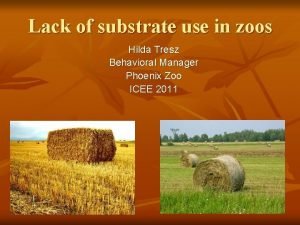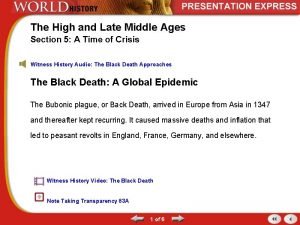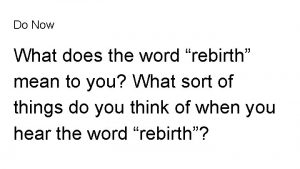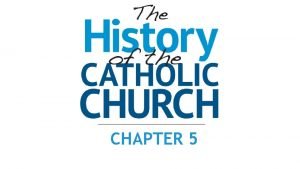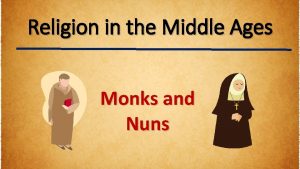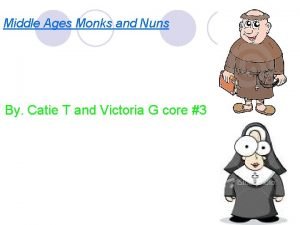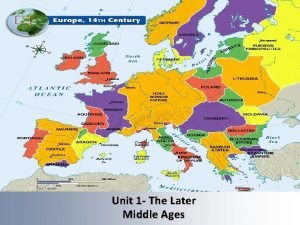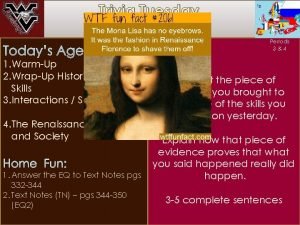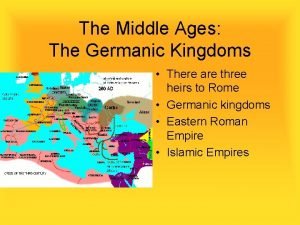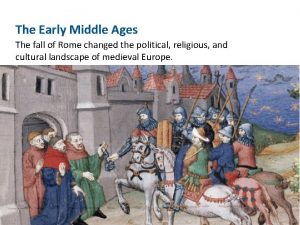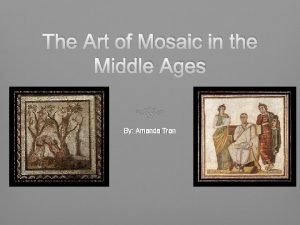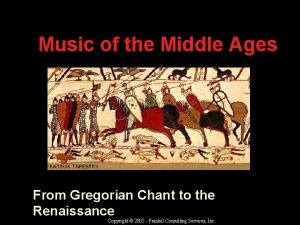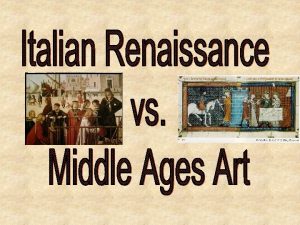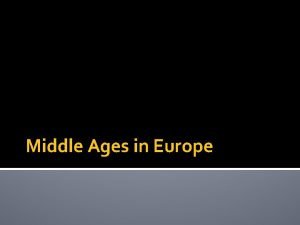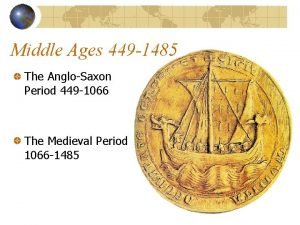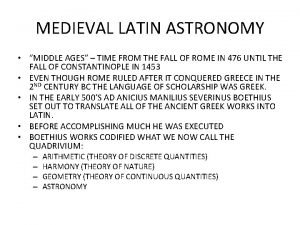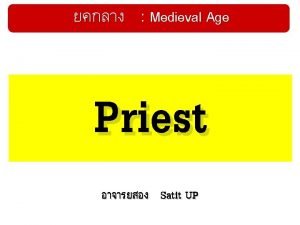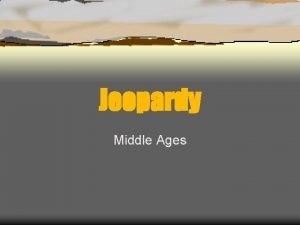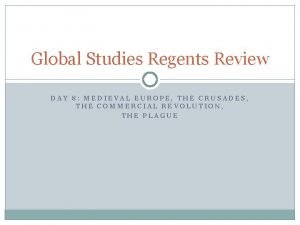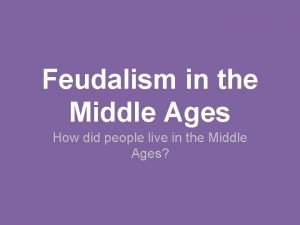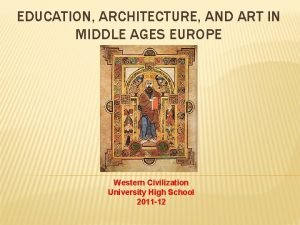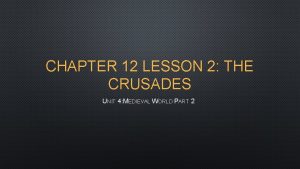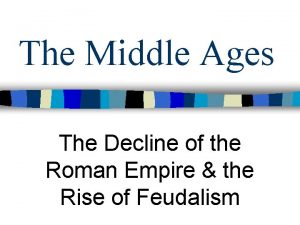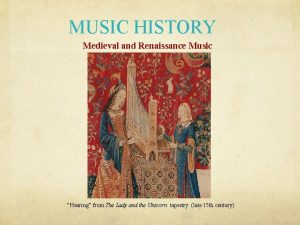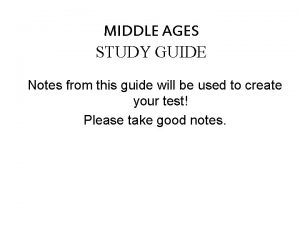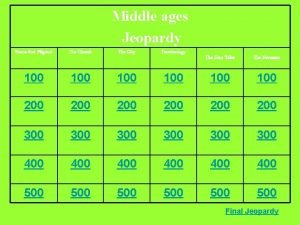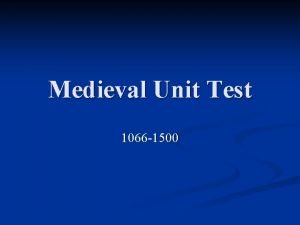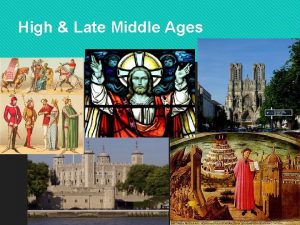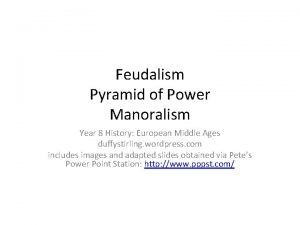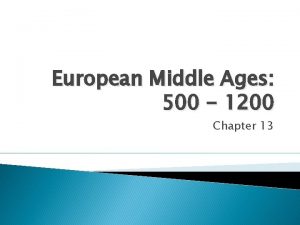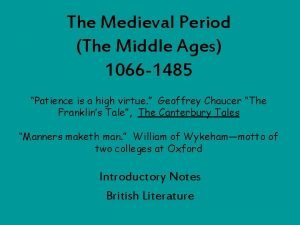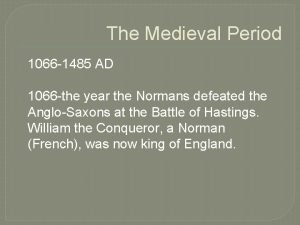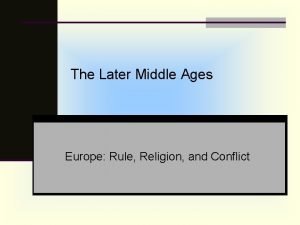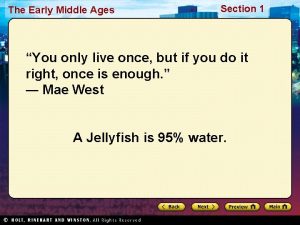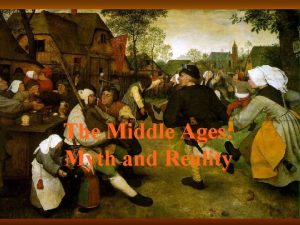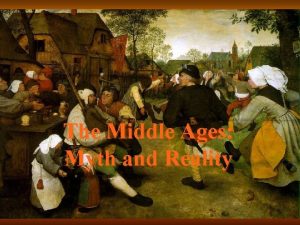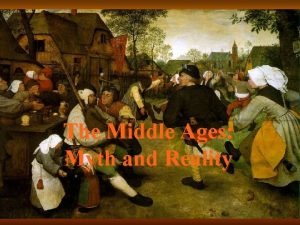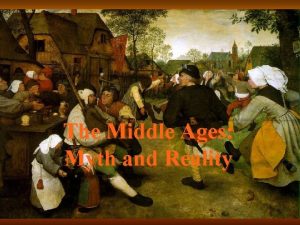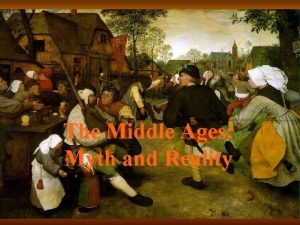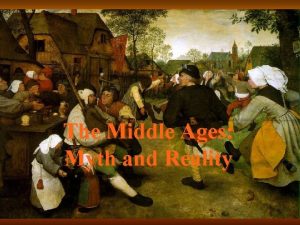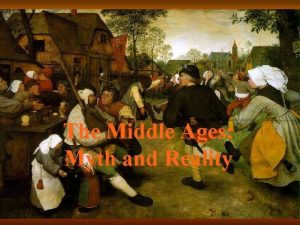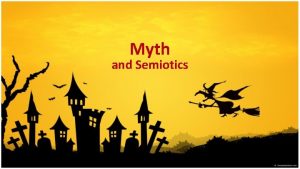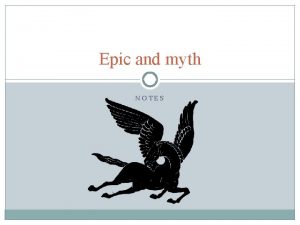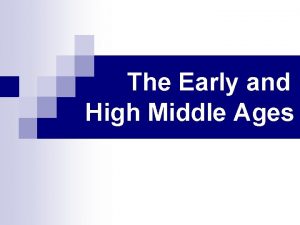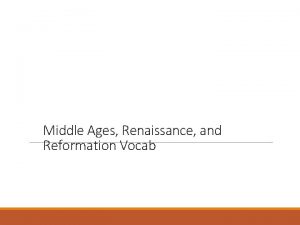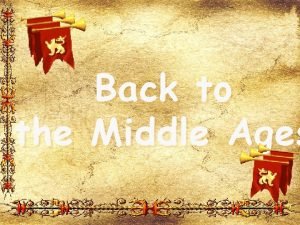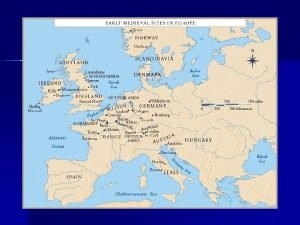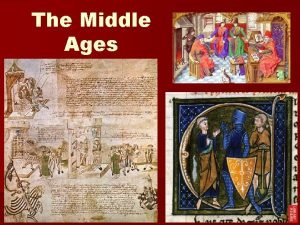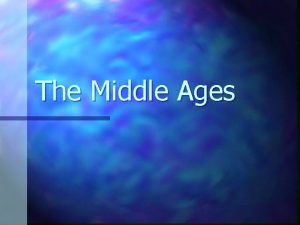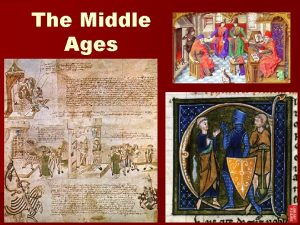The Middle Ages Myth and Reality The Middle











































- Slides: 43

The Middle Ages: Myth and Reality

The Middle Ages: The Myth n n We think of knights in shining armor, lavish banquets, wandering minstrels, kings, queens, bishops, monks, pilgrims, and glorious pageantry. In film and in literature, medieval life seems heroic, entertaining, and romantic.

The Middle Ages: The Reality n In reality, life in the Middle Ages, a period that extended from approximately the 5 th century to the 15 th century in Western Europe, could also be harsh, uncertain, and dangerous.

The Lord of the Manor n For safety and defense, people in the Middle Ages formed small communities around a central lord or master.

The Manor n Most people lived on a manor, which consisted of the castle (or manor house), the church, the village, and the surrounding farm land.


Isolation n These manors were isolated, with occasional visits from peddlers, pilgrims on their way to the Crusades, or soldiers from other fiefdoms.

The Feudal System n Under the feudal system, the king awarded land grants or fiefs to his most important nobles, barons, and bishops, in return for their contribution of soldiers for the king's armies.

Nobles and Vassals n Nobles divided their land among the lesser nobility, who became their vassals. Many of these vassals became so powerful that the kings had difficulty controlling them.

Becoming a Knight n n Needed to be a son from a wealthy family (horses and armor were expensive At age seven, boys became Pages and began their training n n From ages 14 -16, these Pages became Squires, or servants to a Knight. When the Squires were ready, about age 20 -21, they could become Knights…if they’d proved themselves

The Magna Carta n In 1215, the English barons formed an alliance that forced King John to sign the Magna Carta. It limited the king's powers of taxation and required trials by jury. It was the first time that an English monarch was subject to the law.

The Peasants n n At the lowest level of society were the peasants, also called serfs or villeins. The lord offered his peasants protection in exchange for living and working on his land.

Hard Work & High Taxes n n Peasants worked hard to cultivate the land produce the goods that the lord and his manor needed. They were heavily taxed and were required to relinquish much of what they harvested.

MEDIEVAL LIFE Cooperation and Mutual Obligations KING MANORIALISM: ECONOMIC SYSTEM FEUDALISM: POLITICAL SYSTEM Fief and Peasants § Decentralized, local government § Dependent upon the relationship between members of the nobility § Lord and his vassals administered justice and were the highest authority in their land § Agriculture the basis for wealth § Lands divided up into self-sufficient manors § Peasants (serfs) worked the land paid rent In exchange for protection § Barter the usual form of exchange Military Aid Loyalty LORDS (VASSALS TO KING) Food Protection Shelter Military Service Homage KNIGHTS (VASSALS TO LORDS) Food Protection Farm the Land PEASANTS (SERFS) Shelter Pay Rent

Women: Household Chores n n Whether they were nobles or peasants, women held a difficult position in society. They were largely confined to household tasks such as cooking, baking bread, sewing, weaving, and spinning.

Other Occupations n Some medieval women held other occupations. There women blacksmiths, merchants, and apothecaries.

Midwives, Farmers, & Artists n Others were midwives, worked in the fields, or were engaged in creative endeavors such as writing, playing musical instruments, dancing, and painting.

Witches & Nuns n Some women were known as witches, capable of sorcery and healing. Others became nuns and devoted their lives to God and spiritual matters.

The Catholic Church n n The Catholic Church was the only church in Europe during the Middle Ages, and it had its own laws and large income. Church leaders such as bishops and archbishops sat on the king's council and played leading roles in government.

Bishops n n Bishops, who were often wealthy and came from noble families, ruled over groups of parishes called dioceses. Many times, they were part of the feudal system and in exchange for a fief and peasants had to provide homage and military aid to a leige lord.

Parish Priests n n Parish priests, on the other hand, came from humbler backgrounds and often had little education. The village priest tended to the sick and indigent and, if he was able, taught Latin and the Bible to the youth of the village

Monasteries n Monasteries in the Middle Ages were based on the rules set down by St. Benedict in the sixth century. The monks became known as Benedictines and took vows of poverty, chastity, and obedience to their leaders.

Monks n n Monks were required to perform manual labor and were forbidden to own property, leave the monastery, or become entangled in the concerns of society. Daily tasks were often carried out in silence.

Nuns n Monks and their female counterparts, nuns, who lived in convents, provided for the lessfortunate members of the community. Monasteries and nunneries were safe havens for pilgrims and other travelers.

Pilgrimages n Pilgrimages were an important part of religious life in the Middle Ages. Many people took journeys to visit holy shrines such the Canterbury Cathedral in England sites in Jerusalem and Rome.

The Canterbury Tales n Chaucer's Canterbury Tales is a series of stories told by 30 pilgrims as they traveled to Canterbury.

Homes n Most medieval homes were cold, damp, and dark. Sometimes it was warmer and lighter outside the home than within its walls.

Peasants Homes n Many peasant families ate, slept, and spent time together in very small quarters, rarely more than one or two rooms. The houses had thatched roofs and were easily destroyed.



Homes of the Wealthy n The homes of the rich were more elaborate than the peasants' homes. Their floors were paved, as opposed to being strewn with rushes and herbs, and sometimes decorated with tiles. Tapestries were hung on the walls, providing not only decoration but also an extra layer of warmth.


Health & Hygiene n As the populations of medieval towns and cities increased, hygienic conditions worsened, leading to a vast array of health problems.

Medicine n Medical knowledge was limited and, despite the efforts of medical practitioners and public and religious institutions to institute regulations, medieval Europe did not have an adequate health care system. Antibiotics weren't invented until the 1800 s and it was almost impossible to cure diseases without them.

Myths and Superstitions n There were many myths and superstitions about health and hygiene as there still are today. People believed, for example, that disease was spread by bad odors. It was also assumed that diseases of the body resulted from sins of the soul. Many people sought relief from their ills through meditation, prayer, pilgrimages, and other nonmedical methods.

Bloodletting n Medicine was often a risky business. Bloodletting was a popular method of restoring a patient's health and "humors. " Early surgery, often done by barbers without anesthesia, must have been excruciating.

Medical Treatment n Medical treatment was available mainly to the wealthy, and those living in villages rarely had the help of doctors, who practiced mostly in the cities and courts. Remedies were often herbal in nature, but also included ground earthworms, urine, and animal excrement.

Arts & Entertainment n Art and music were critical aspects of medieval religious life and, towards the end of the Middle Ages, secular life as well. Singing without instrumental accompaniment was an essential part of church services. Monks and priests chanted the divine offices and the mass daily.

Town Life n After 1000, peace and order grew. As a result, peasants began to expand their farms and villages further into the countryside. The earliest merchants were peddlers who went from village to village selling their goods.

The Printing Press n Printing began in 1450 with the publication of the Bible by Johannes Gutenberg. This revolutionized the spread of learning. Other inventions of the time included mechanical clocks, tower mills, and guns.

The Birth of the Renaissance n The inventions of Leonardo da Vinci and the voyages of discovery in the fifteenth century contributed to the birth of the Renaissance.

Urban Life n Few serfs were left in Europe by the end of the Middle Ages, and the growing burgher class became very powerful. Hard work and enterprise led to economic prosperity and a new social order. Urban life brought with it a new freedom for individuals.

References n Adapted from the Annenberg Media/Learner. org website “The Middle Ages” http: //www. learner. org/exhibits/middleages/
 Dark ages vs middle ages
Dark ages vs middle ages Dark ages vs middle ages
Dark ages vs middle ages Zoos connect us to the natural world claim
Zoos connect us to the natural world claim Zoos myth and reality answers
Zoos myth and reality answers The high and late middle ages section 5 quiz
The high and late middle ages section 5 quiz Middle ages renaissance
Middle ages renaissance Similarities between middle ages and renaissance
Similarities between middle ages and renaissance Monks and nuns in the middle ages
Monks and nuns in the middle ages Monks and nuns middle ages
Monks and nuns middle ages Map of europe in middle ages
Map of europe in middle ages Dark ages vs renaissance
Dark ages vs renaissance Germanic kingdoms
Germanic kingdoms History of floral design crossword
History of floral design crossword Early middle ages
Early middle ages Dark ages mosaic
Dark ages mosaic Late middle ages timeline
Late middle ages timeline Gregorian chant middle ages
Gregorian chant middle ages Renaissance vs middle ages
Renaissance vs middle ages Middle ages def
Middle ages def A metaphorical phrase used to replace a concrete noun
A metaphorical phrase used to replace a concrete noun Astronomy in the middle ages
Astronomy in the middle ages The catholic church hierarchy pyramid
The catholic church hierarchy pyramid Middle ages jeopardy
Middle ages jeopardy What were two indirect results of the crusades
What were two indirect results of the crusades Feudal system in the middle ages
Feudal system in the middle ages Cathedral art
Cathedral art Middle ages def
Middle ages def Chapter 12 lesson 3 culture of the middle ages
Chapter 12 lesson 3 culture of the middle ages Art of emerging europe example
Art of emerging europe example Middle ages
Middle ages The middle ages spans nearly one thousand years.
The middle ages spans nearly one thousand years. Middle ages study guide answer key
Middle ages study guide answer key Language answer
Language answer The middle ages 1066 to 1485 unit test
The middle ages 1066 to 1485 unit test English-georgian period floral design
English-georgian period floral design Copyright
Copyright Pyramid of power in middle ages
Pyramid of power in middle ages 500
500 The middle ages outcome the power of the church
The middle ages outcome the power of the church Medieval period 1066 to 1485
Medieval period 1066 to 1485 The middle ages 1066-1485 unit test
The middle ages 1066-1485 unit test Early middle ages
Early middle ages Middle ages nobles
Middle ages nobles Sacred music in the middle ages
Sacred music in the middle ages



